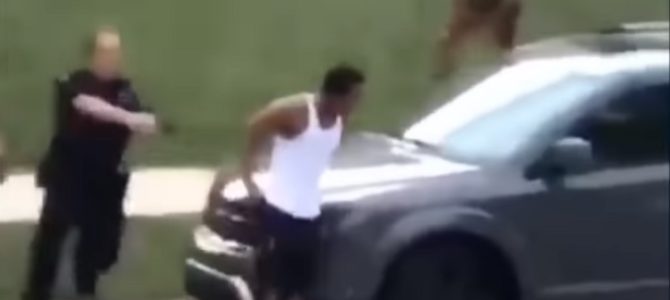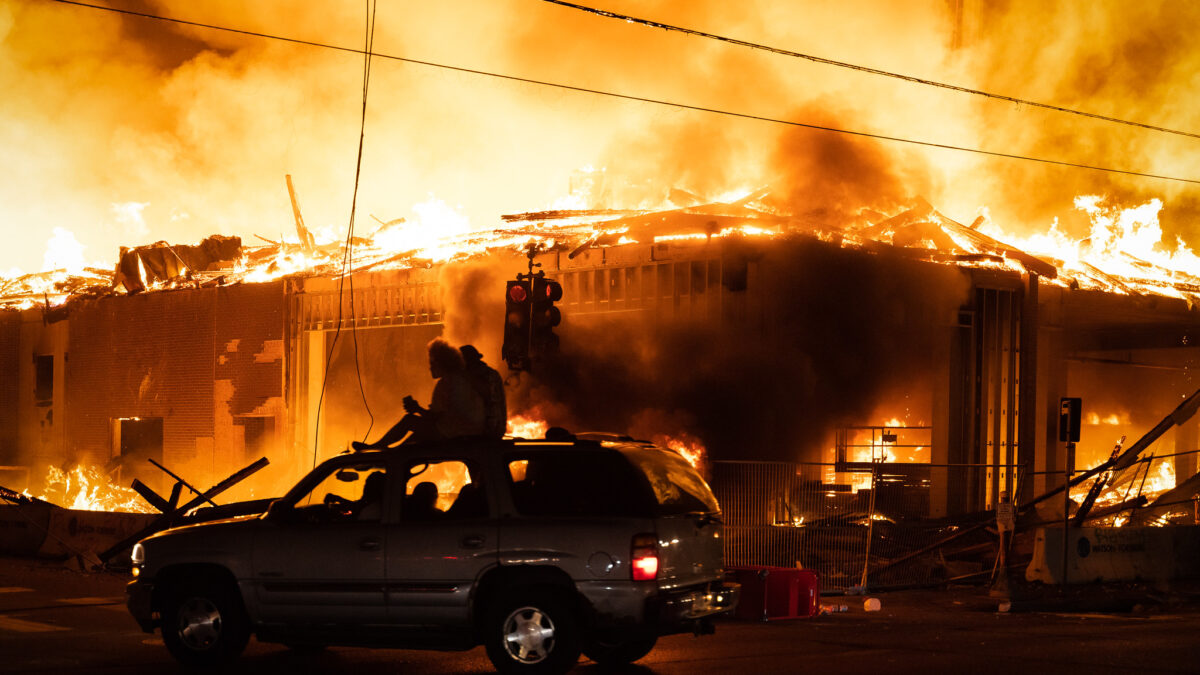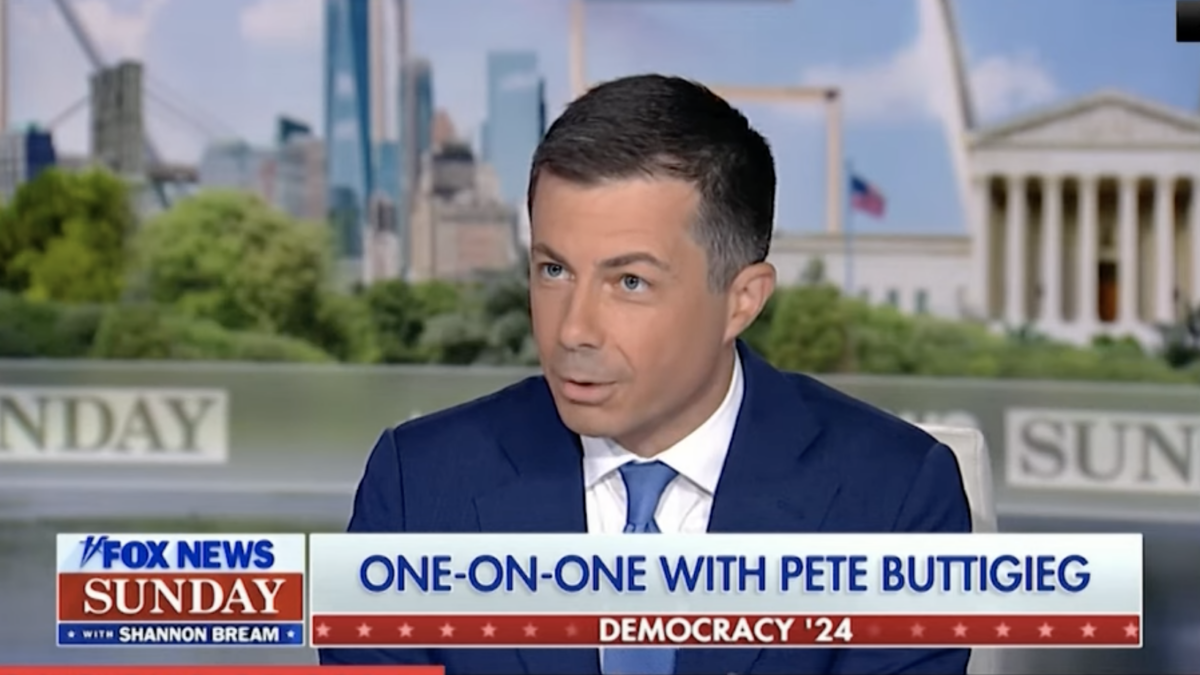
A week ago Sunday, social media erupted when a graphic video emerged showing a white Kenosha, Wisconsin police officer shoot, multiple times, a black man in the back as he attempted to enter a vehicle containing three children. The man later identified as 29-year-old Jacob Blake survived, and remains hospitalized.
As the video went viral, violence erupted in this mid-sized Wisconsin community. Rather than call for calm, Wisconsin’s first-term governor, Democrat Tony Evers, fueled the outrage by framing the shooting as yet another “Black man or person” “shot or injured or mercilessly killed at the hands of individuals in law enforcement in our state or our country.”
While acknowledging “we do not have all of the details yet,” Evers nonetheless stressed that “Blake was shot in the back multiple times, in broad daylight.” He promised to “stand against excessive use of force” in a statement all but declaring the police officer a criminal.
Riots Escalate Immediately
The street violence escalated that night, and by Monday morning rioters had set a fire at a county courthouse, broken windows and spray-painted graffiti at the Kenosha County administrative building, and incinerated the lot of a nearby auto dealership, as well as dump trucks and garbage trucks.
Things worsened on Tuesday. During intensified rioting, two men were killed and a third injured by 17-year-old Kyle Rittenhouse. Rittenhouse, who has been charged with multiple felonies, including first-degree murder, is claiming self-defense in the shootings.
By Wednesday, the narrative — that a white police officer had without justification shot an unarmed black many seven times in his back in front of his three young children — was making other waves. The Milwaukee Bucks declared a boycott of the NBA playoff, other teams followed, and then the NHL. Then Democratic presidential candidate Joe Biden entered the fray.
“What I saw on that video makes me sick,” Biden announced. “Once again a black man, Jacob Blake, has been shot by the police in broad daylight with the whole world watching,” Biden said in a video posting, adding “he had spoken to Blake’s family and assured them that ‘justice must and will be done.’” Like his fellow Democrat Evers, Biden then pronounced judgment on the officers by applauding those protesting the police.
While this narrative was dominating the news and social media, more facts began to dribble out. On Friday, a lawyer for the Kenosha police union issued a statement exposing even more details. Those facts—which are verified by audio and video recordings, the onboard Taser memory units, and physical evidence—establish that the shooting of Blake was legally justified.
The media, most Americans, and professional athletes have no understanding of what constitutes “reasonable force” for police. Yes, it sometimes includes shooting a man, in broad daylight, in the back seven times.
Let’s Go Through Legal Principles for Use of Force
Well-established legal principles govern the use of “deadly force” by law enforcement officers. Initially, it is important to stress that the law is clear that an officer cannot use deadly force “merely to prevent a felon’s escape.” Thus, shooting Blake would not be justified based solely on the fact that there was an outstanding felony charge against Blake and the officers were attempting to arrest him.
However, while generally police may not use deadly force to effectuate an arrest, the Supreme Court has made clear that deadly force may be used if “the officer has probable cause to believe that the suspect poses a threat of serious physical harm, either to the officer or others.”
In the videos, Blake appeared to be armed with a knife. It has been established that a knife was found in the car he was reaching into, although whether he possessed it during his altercation with police is unclear. The mere fact that Blake may have been armed with a knife, though, also does not justify the shooting. Rather, objective reasonableness is determined based on “whether the totality of the circumstances justified the use of force.”
In determining the objective reasonableness of force, consideration is given to the severity of the crime at issue, whether the suspect is actively resisting arrest or attempting to evade arrest by flight, the suspect’s demeanor, whether the suspect is intoxicated or noncompliant, whether the suspect has a weapon, whether the officers ordered the suspect to drop the weapon, the distance separating the officers and the suspect, and whether any hostile motions with the weapon were made.
The key question in this analysis is whether the suspect “poses a threat.” “A nascent threat can be sufficient; it need not materialize to the point of harm.” Thus, an officer need not wait until a suspect knives or shoots someone, but “may anticipatorily use a weapon to protect himself or others.” In other words, “[i]t is the perceived threat of attack by a suspect, apart from the actual attack, to which the officer may respond preemptively.”
Put otherwise, “a reasonable officer need not await the ‘glint of steel’ before taking self-protective action; by then, it is ‘often . . . too late to take safety precautions.’”
Let’s Return to the Scene
Against these well-established legal principles, then, let’s return to the scene of the Blake shooting on August 23, 2020. Officers were dispatched to the home of Blake’s on-again, off-again girlfriend when she called 911. A dispatcher told officers the caller said Blake “isn’t supposed to be there,” and that he “took the complainant’s keys and is refusing to give them back.” A moment later, the dispatch informed officers that “we have an alert at this address for a 99 for this subject,” meaning there was an outstanding warrant for Blake’s arrest.
Before officers could arrive, dispatch informed them the caller had become uncooperative and said Blake had left then hung up. While Blake’s family and the police present two starkly different versions of what occurred at that point, video, audio, and physical evidence can easily confirm the following.
Blake was struggling with the officers before the shooting, and two separate officers discharged Tasers at Blake, but the Tasers failed to subdue him. Video also captured Blake struggling with the officers as they tried to arrest him, but Blake was able to break free. Video then showed Blake, with what may have been a knife in his hand, walk around the SUV, open the driver’s side door, and move towards the interior of the automobile. (The knife was later recorded on the floor of the SUV.)
While Blake advanced toward the automobile, the officers appear to have been shouting for him to drop the knife. As Blake moved to get inside the SUV, one officer held his shirt and then fired seven shots. Blake’s three children were inside of the SUV, and according to the children’s mother, Laquisha Booker, the officers knew “they were in there because I kept screaming that.”
These facts make clear that the officer’s shooting of Blake was justified for two independent reasons. First, courts recognize that “deadly force is presumptively reasonable” when an “officer could reasonably have interpreted the suspect’s movement as ‘reaching for a weapon.’”
When Blake ignored the officers’ commands and instead opened the SUV and leaned in with his upper body, the officers could reasonably have believed Blake was going for a gun, justifying the use of deadly force. As a legal matter, that the officer shot Blake seven times, and not once or twice, is irrelevant because the fact that “multiple shots were fired does not suggest the officers shot mindlessly as much as it indicates that they sought to ensure the elimination of a deadly threat.”
Blake’s Realistic Threat to the Kids Inside the SUV
While police had a legal right to shoot Blake to protect themselves, protecting the three innocent children in the SUV provides an even stronger justification for the shooting. The officers who had responded to the 911 call knew from dispatch several facts: Blake was “not supposed to be there”; he had an outstanding warrant for his arrest; and he had taken the caller’s keys.
They also knew that Blake had resisted arrest; two Taser shots failed to incapacitate Blake; Blake may have been armed with a knife; Blake refused to comply with the officers’ commands; a panicked mom was screaming that her kids were in the car; and that Blake was attempting to enter the SUV.
Under these circumstances, an officer could reasonably believe that Blake posed a threat of serious physical harm to the three young children, either directly, by means of a weapon he possessed in the closed quarters of the automobile, or indirectly by attempting to evade police with the kids, aged 8, 5, and 3, hostage in the backseat of the SUV.
A lawyer for Blake’s family is attempting to spin Blake’s conduct as innocent, claiming he was merely checking to ensure his kids were okay. Even if that was a believable explanation for Blake’s behavior, however, in judging the reasonableness of a police officer’s conduct, the law makes clear that facts must “be filtered through the lens of the officer’s perceptions at the time of the incident,” “considering what the officer perceived and knew at the time, “rather than with the 20/20 vision of hindsight.”
In addition, “the calculus of reasonableness must embody allowance for the fact that police officers are often forced to make split-second judgments—in circumstances that are tense, uncertain, and rapidly evolving—about the amount of force that is necessary in a particular situation.”
Or, as the courts say, “We must never allow the theoretical, sanitized world of our imagination to replace the dangerous and complex world that policemen face every day. What constitutes ‘reasonable’ action may seem quite different to someone facing a possible assailant than to someone analyzing the question at leisure.”
Should Police Have Instead Let Blake Drive Off?
While second-guessing is not appropriate, in this case, it is illuminating. While critics are claiming the officer didn’t have to shoot Blake, they fail to explain what the officer should have done instead.
Police attempted to Tase Blake—twice. They attempted to physically restrain Blake. Those efforts failed as well. There was but a split-second left to keep Blake from getting behind the wheel and escaping with the three children, while possibly armed. Shooting Blake was the only option left to ensure the children’s safety.
Despite attempts to now portray Blake as the happy family man, his threat to the children was real, as it, unfortunately, is in most cases involving domestic abuse.
According to Booker—now amazingly describing herself as Blake’s fiancé—in a May 2020 criminal complaint, she filed against him, over their eight-year on-again, off-again relationship Blake physically abused her. In the early morning of May 3, 2020, Booker told police that Blake, described as her “ex-boyfriend,” broke into her apartment and sexually assaulted her. He then stole the keys to her SUV and a debit card.
In the complaint of just three months ago, Booker also explained that over the past eight years, Blake has “physically assaulted her around twice a year when he drinks heavily.” The criminal complaint further revealed that Booker and Blake never resided together, that he is unemployed, has no vehicle, and refused to tell Booker where he was currently living.
While the officers did not know those facts at the time of their encounter with Blake, they knew enough to make them reasonably fear for the children’s safety (as well as their own), making the use of deadly force appropriate in this case. Yes, Blake remains hospitalized in critical condition, but better him than the three innocent children. Those black lives matter too.









